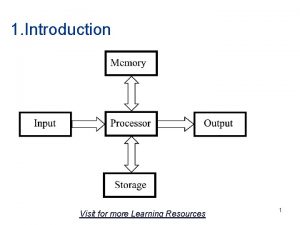Graphs Chapter 7 Visit for more Learning Resources






























![Example of List L[0]: empty L[1]: empty L[2]: 0, 1, 4, 5 L[3]: 0, Example of List L[0]: empty L[1]: empty L[2]: 0, 1, 4, 5 L[3]: 0,](https://slidetodoc.com/presentation_image_h/32f49fb214141521d5d3f4f93e42dfe7/image-31.jpg)





















































- Slides: 84

Graphs Chapter 7 Visit for more Learning Resources

What is a graph? A data structure that consists of a set of finite nodes (V) and a set of edges(E) that relate the nodes to each other G=(V, E) V(G)=Vertices of graph G , e. g. {1, 2, 3, 4} E(G)=Edges of graph G , e. g. {(1, 2), (1, 3), (3, 4)} 1 2 4 3

Graphs • Vertices are also called nodes and points. • E is the edge set. • Each edge connects two different vertices. • Edges are also called arcs and lines. • Directed edge has an orientation (u, v). u v

Graphs • Undirected edge has no orientation (u, v). u v • Undirected graph => no oriented edge. • Directed graph => every edge has an orientation.

Undirected Graph 2 3 8 1 10 4 5 6 9 7 11

Directed Graph (Digraph) 2 3 8 1 10 4 5 6 9 7 11

Applications—Communication Network 2 3 8 1 10 4 5 6 9 7 • Vertex = city, edge = communication link. 11

Driving Distance/Time Map 2 4 3 8 8 1 6 2 10 4 4 4 5 5 9 5 6 6 7 7 • Vertex = city, edge weight = driving distance/time. 3 11

Street Map 2 3 8 1 10 4 5 6 • Some streets are one way. 9 7 11

Complete Undirected Graph Has all possible edges. n=1 n=2 n=3 n=4

Number Of Edges—Undirected Graph • Each edge is of the form (u, v) • Number of such pairs in an n vertex graph is n(n-1). • Since edge (u, v) is the same as edge (v, u), the number of edges in a complete undirected graph is n(n-1)/2. • Number of edges in an undirected graph is <= n(n-1)/2.

Number Of Edges—Directed Graph • Each edge is of the form (u, v), u != v. • Number of such pairs in an n vertex graph is n(n-1). • Since edge (u, v) is not the same as edge (v, u), the number of edges in a complete directed graph is n(n-1). • Number of edges in a directed graph is <= n(n-1).

Graph terminology 1. Adjacent nodes: two nodes are adjacent if they are connected by an edge 2. Path: A sequence of edges that connect two nodes in a graph 3. Path Length: Total no of edges included in path. 4. Complete graph: a graph in which every vertex is directly connected to every other vertex 5 is adjacent to 7 7 is adjacent from 5

Graph terminology (cont. ) What is the number of edges in a complete directed graph with N vertices? N * (N-1)

Graph terminology (cont. ) What is the number of edges in a complete undirected graph with N vertices? N * (N-1) / 2

5. Vertex Degree OR Degree of Node 2 3 8 1 10 4 5 6 9 7 Number of edges incident to vertex. degree(2) = 2, degree(5) = 3, degree(3) = 1 11

6. In-Degree Of A Vertex 2 3 8 1 4 5 6 in-degree is number of incoming edges indegree(2) = 1, indegree(8) = 0 9 7 10 11

7. Out-Degree Of A Vertex 2 3 8 1 4 5 6 9 7 out-degree is number of outbound edges outdegree(2) = 1, outdegree(8) = 2 10 11

Graph terminology (cont. ) 8. Source: A Node which has only outgoing edges. 9. Sink: A Node which has only Incoming edges. 10. Pendant Node: if indegree of node is 1 and outdegree is 0 then it is pendant Node. 11. Reachable: If path exist between two nodes then they are reachable.

Graph terminology (cont. ) 12. Sling or loop: An edge of graph which joins a node to itself is called sling or loop. 13. Parallel Edges: The two distinct edges between a pair to nodes which are opposite in a direction. 14. Weighted Edge: edge has Numerical Values. 15. Isolated Node: Not an Adjacent node of any other node

Graph terminology (cont. ) 16. Weighted graph: a graph in which each edge carries a value 2 4 3 8 8 1 6 2 10 4 4 4 5 9 5 6 6 7 7 5 3 11

Graph terminology (cont. ) 17. Isolated Graph: A Graph which contain only isolated node. 18. Directed Acyclic Graph: A diagraph with no cycles. 2 1 5 4

Graph implementation Array-based implementation A 1 D array is used to represent the vertices A 2 D array (adjacency matrix) is used to represent the edges

Graph Representation There are two ways to represent the Graph: 1. 2. Sequential Representation 1. Adjacency Matrix 2. Path Matrix Adjacency Lists/Linked List representation.

1. Adjacency Matrix • • 0/1 n x n matrix, where n = # of vertices A(i, j) = 1 iff (i, j) is an edge 2 3 1 4 5 1 2 3 4 5 1 0 1 0 2 1 0 0 0 1 3 0 0 1 4 1 0 0 0 1 5 0 1 1 1 0

Path Matrix

Path Matrix


Adjacency Lists • Adjacency list for vertex i is a linear list of vertices adjacent from vertex i. • An array of n adjacency lists. a. List[1] = (2, 4) 2 3 a. List[2] = (1, 5) a. List[3] = (5) 1 4 a. List[4] = (5, 1) 5 a. List[5] = (2, 4, 3)

Adjacency Lists Representation • A graph of n nodes is represented by a one-dimensional array L of linked lists, where • L[i] is the linked list containing all the nodes adjacent from node i. • The nodes in the list L[i] are in no particular order
![Example of List L0 empty L1 empty L2 0 1 4 5 L3 0 Example of List L[0]: empty L[1]: empty L[2]: 0, 1, 4, 5 L[3]: 0,](https://slidetodoc.com/presentation_image_h/32f49fb214141521d5d3f4f93e42dfe7/image-31.jpg)
Example of List L[0]: empty L[1]: empty L[2]: 0, 1, 4, 5 L[3]: 0, 1, 4, 5 L[4]: 0, 1 L[5]: 0, 1 Mary 0 Helen 1 Joe 3 John 2 Tom 4 Paul 5

Linked Adjacency Lists • Each adjacency list is a chain. 2 3 1 4 5 a. List[1] [2] [3] [4] a. List[5] 2 1 5 5 2 Array Length = n # of chain nodes = 2 e (undirected graph) # of chain nodes = e (digraph) 4 5 1 4 3

Array Adjacency Lists • Each adjacency list is an array list. 2 3 1 4 5 a. List[1] [2] [3] [4] a. List[5] 2 1 5 5 2 Array Length = n # of list elements = 2 e (undirected graph) # of list elements = e (digraph) 4 5 1 4 3

Graph Search (traversal) • How do we search a graph? • At a particular vertices, where shall we go next? • Two common Methods: § Breadth-first search (BFS) § Depth-first search (DFS) • In BFS, one explore a graph level by level away (explore all neighbors first and then move on) • In DFS, go as far as possible along a single path until reach a dead end (a vertex with no edge out or no neighbor unexplored) then backtrack Data Structure and Algorithm

Graph Search Methods • A vertex u is reachable from vertex v iff there is a path from v to u. 2 3 8 1 4 5 9 10 6 7 11

Graph Search Methods • A search method starts at a given vertex v and visits/labels/marks every vertex that is reachable from v. 2 3 8 1 4 5 9 10 6 7 11

Breadth-First Search • Visit start vertex and put into a FIFO queue. • Repeatedly remove a vertex from the queue, visit its unvisited adjacent vertices, put newly visited vertices into the queue.

Breadth-First Search Example 2 3 8 1 4 5 9 10 6 Start search at vertex 1. 7 11

Breadth-First Search Example 2 FIFO Queue 3 8 1 4 5 1 9 10 6 7 11 Visit/mark/label start vertex and put in a FIFO queue.

Breadth-First Search Example 2 FIFO Queue 3 8 1 4 5 1 9 10 6 7 11 Remove 1 from Q; visit adjacent unvisited vertices; put in Q.

Breadth-First Search Example 2 FIFO Queue 2 4 3 8 1 4 5 9 10 6 7 11 Remove 1 from Q; visit adjacent unvisited vertices; put in Q.

Breadth-First Search Example 2 FIFO Queue 2 4 3 8 1 4 5 9 10 6 7 11 Remove 2 from Q; visit adjacent unvisited vertices; put in Q.

Breadth-First Search Example 2 FIFO Queue 4 5 3 6 3 8 1 4 5 9 10 6 7 11 Remove 2 from Q; visit adjacent unvisited vertices; put in Q.

Breadth-First Search Example 2 FIFO Queue 4 5 3 6 3 8 1 4 5 9 10 6 7 11 Remove 4 from Q; visit adjacent unvisited vertices; put in Q.

Breadth-First Search Example 2 FIFO Queue 5 3 6 3 8 1 4 5 9 10 6 7 Remove 4 from Q; visit adjacent unvisited vertices; put in Q. 11

Breadth-First Search Example 2 FIFO Queue 5 3 6 3 8 1 4 5 9 10 6 7 Remove 5 from Q; visit adjacent unvisited vertices; put in Q. 11

Breadth-First Search Example 2 FIFO Queue 3 6 9 7 3 8 1 4 5 9 10 6 7 Remove 5 from Q; visit adjacent unvisited vertices; put in Q. 11

Breadth-First Search Example 2 FIFO Queue 3 6 9 7 3 8 1 4 5 9 10 6 7 Remove 3 from Q; visit adjacent unvisited vertices; put in Q. 11

Breadth-First Search Example 2 FIFO Queue 6 9 7 3 8 1 4 5 9 10 6 7 Remove 3 from Q; visit adjacent unvisited vertices; put in Q. 11

Breadth-First Search Example 2 FIFO Queue 6 9 7 3 8 1 4 5 9 10 6 7 Remove 6 from Q; visit adjacent unvisited vertices; put in Q. 11

Breadth-First Search Example 2 FIFO Queue 9 7 3 8 1 4 5 9 10 6 7 Remove 6 from Q; visit adjacent unvisited vertices; put in Q. 11

Breadth-First Search Example 2 FIFO Queue 9 7 3 8 1 4 5 9 10 6 7 Remove 9 from Q; visit adjacent unvisited vertices; put in Q. 11

Breadth-First Search Example 2 FIFO Queue 7 8 3 8 1 4 5 9 10 6 7 Remove 9 from Q; visit adjacent unvisited vertices; put in Q. 11

Breadth-First Search Example 2 FIFO Queue 7 8 3 8 1 4 5 9 10 6 7 Remove 7 from Q; visit adjacent unvisited vertices; put in Q. 11

Breadth-First Search Example 2 FIFO Queue 8 3 8 1 4 5 9 10 6 7 Remove 7 from Q; visit adjacent unvisited vertices; put in Q. 11

Breadth-First Search Example 2 FIFO Queue 8 3 8 1 4 5 9 10 6 7 Remove 8 from Q; visit adjacent unvisited vertices; put in Q. 11

Breadth-First Search Example 2 FIFO Queue 3 8 1 4 5 9 10 6 7 Queue is empty. Search terminates. 11

Breadth-First Search Property • All vertices reachable from the start vertex (including the start vertex) are visited.

Breadth-first Search (BFS) • Search for all vertices that are directly reachable from the root (called level 1 vertices) • After mark all these vertices, visit all vertices that are directly reachable from any level 1 vertices (called level 2 vertices), and so on. Data Structure and Algorithm

Example r s t u v w x y Data Structure and Algorithm

Example r s t t u u 0 x y v w w v Q: s Data Structure and Algorithm x y

Example r s t u 1 0 1 v w x y Q: w Data Structure and Algorithm r

Example r s r t s t u u 1 0 2 1 2 v w w v Q: r Data Structure and Algorithm t x x x y y

Example r s r t s t u u 1 0 2 2 1 2 v w w v Q: t Data Structure and Algorithm x x v x y y

Example r s r t s t u u 1 0 2 3 2 1 2 v w w v Q: x Data Structure and Algorithm v x u x y y

Example r s r t s t u u 1 0 2 3 2 1 2 3 v w w v Q: v Data Structure and Algorithm u x y y

Example r s t t u u 1 0 2 3 2 1 2 3 v w w v Q: u Data Structure and Algorithm y x x y y

Example r s t t u u 1 0 2 3 2 1 2 3 v w w v Q: y Data Structure and Algorithm x x y y

Example r s t t u u 1 0 2 3 2 1 2 3 v w w v x x Q: AllØVertices are Visited……. . Data Structure and Algorithm y y

Depth-First Search (DFS) • The basic idea behind this algorithm is that it traverses the graph using recursion • Go as far as possible until you reach a dead end • Backtrack to the previous path and try the next branch • The graph below, started at node a, would be visited in the following order: a, b, c, g, h, i, e, d, f, j a b d c e g Data Structure and Algorithm h i f j

Depth-First Search depth. First. Search(v) { Label vertex v as reached. for (each unreached vertex u adjacenct from v) depth. First. Search(u); }

Depth-First Search Example 2 3 8 1 4 5 9 10 6 7 11 Start search at vertex 1. Label vertex 1 and do a depth first search from either 2 or 4. Suppose that vertex 2 is selected.

Depth-First Search Example 2 3 8 1 4 5 9 10 6 7 11 Label vertex 2 and do a depth first search from either 3, 5, or 6. Suppose that vertex 5 is selected.

Depth-First Search Example 2 3 8 1 4 5 9 10 6 7 11 Label vertex 5 and do a depth first search from either 3, 7, or 9. Suppose that vertex 9 is selected.

Depth-First Search Example 2 3 8 1 4 5 9 10 6 7 11 Label vertex 9 and do a depth first search from either 6 or 8. Suppose that vertex 8 is selected.

Depth-First Search Example 2 3 8 1 4 5 9 10 6 7 11 Label vertex 8 and return to vertex 9. From vertex 9 do a dfs(6).

Depth-First Search Example 2 3 8 1 4 5 9 10 6 7 11 Label vertex 6 and do a depth first search from either 4 or 7. Suppose that vertex 4 is selected.

Depth-First Search Example 2 3 8 1 4 5 9 10 6 Label vertex 4 and return to 6. From vertex 6 do a dfs(7). 7 11

Depth-First Search Example 2 3 8 1 4 5 9 10 6 Label vertex 7 and return to 6. Return to 9. 7 11

Depth-First Search Example 2 3 8 1 4 5 9 10 6 Return to 5. 7 11

Depth-First Search Example 2 3 8 1 4 5 9 10 6 Do a dfs(3). 7 11

Depth-First Search Example 2 3 8 1 4 5 9 10 6 Label 3 and return to 5. Return to 2. 7 11

Depth-First Search Example 2 3 8 1 4 5 9 10 6 Return to 1. 7 11

Depth-First Search Example 2 3 8 1 4 5 9 10 6 7 11 Return to invoking method. For more detail contact us
 More more more i want more more more more we praise you
More more more i want more more more more we praise you More more more i want more more more more we praise you
More more more i want more more more more we praise you State graph in software testing
State graph in software testing Speed and velocity
Speed and velocity Graphs that enlighten and graphs that deceive
Graphs that enlighten and graphs that deceive Degree and leading coefficient
Degree and leading coefficient Cuadro comparativo e-learning y b-learning
Cuadro comparativo e-learning y b-learning Transformed and transforming resources
Transformed and transforming resources Fixed and variable resources
Fixed and variable resources Renewable resources vs nonrenewable resources
Renewable resources vs nonrenewable resources Balance the workload across two or more it resources.
Balance the workload across two or more it resources. Inductive representation learning on large graphs.
Inductive representation learning on large graphs. The more you take the more you leave behind
The more you take the more you leave behind The more you study the more you learn
The more you study the more you learn Aspire not to
Aspire not to Law of inertia example
Law of inertia example Knowing more remembering more
Knowing more remembering more More love to thee o lord
More love to thee o lord More choices more chances
More choices more chances Human history becomes more and more a race
Human history becomes more and more a race Kontinuitetshantering i praktiken
Kontinuitetshantering i praktiken Novell typiska drag
Novell typiska drag Tack för att ni lyssnade bild
Tack för att ni lyssnade bild Returpilarna
Returpilarna Varför kallas perioden 1918-1939 för mellankrigstiden?
Varför kallas perioden 1918-1939 för mellankrigstiden? En lathund för arbete med kontinuitetshantering
En lathund för arbete med kontinuitetshantering Personalliggare bygg undantag
Personalliggare bygg undantag Tidbok yrkesförare
Tidbok yrkesförare Anatomi organ reproduksi
Anatomi organ reproduksi Förklara densitet för barn
Förklara densitet för barn Datorkunskap för nybörjare
Datorkunskap för nybörjare Tack för att ni lyssnade bild
Tack för att ni lyssnade bild Debatt artikel mall
Debatt artikel mall Magnetsjukhus
Magnetsjukhus Nyckelkompetenser för livslångt lärande
Nyckelkompetenser för livslångt lärande Påbyggnader för flakfordon
Påbyggnader för flakfordon Arkimedes princip formel
Arkimedes princip formel Offentlig förvaltning
Offentlig förvaltning Kyssande vind
Kyssande vind Presentera för publik crossboss
Presentera för publik crossboss Vad är ett minoritetsspråk
Vad är ett minoritetsspråk Plats för toran ark
Plats för toran ark Treserva lathund
Treserva lathund Epiteltyper
Epiteltyper Bästa kameran för astrofoto
Bästa kameran för astrofoto Cks
Cks Verifikationsplan
Verifikationsplan Mat för unga idrottare
Mat för unga idrottare Verktyg för automatisering av utbetalningar
Verktyg för automatisering av utbetalningar Rutin för avvikelsehantering
Rutin för avvikelsehantering Smärtskolan kunskap för livet
Smärtskolan kunskap för livet Ministerstyre för och nackdelar
Ministerstyre för och nackdelar Tack för att ni har lyssnat
Tack för att ni har lyssnat Hur ser ett referat ut
Hur ser ett referat ut Redogör för vad psykologi är
Redogör för vad psykologi är Stål för stötfångarsystem
Stål för stötfångarsystem Atmosfr
Atmosfr Borra hål för knoppar
Borra hål för knoppar Vilken grundregel finns det för tronföljden i sverige?
Vilken grundregel finns det för tronföljden i sverige? Stickprovsvarians
Stickprovsvarians Tack för att ni har lyssnat
Tack för att ni har lyssnat Steg för steg rita
Steg för steg rita Ledningssystem för verksamhetsinformation
Ledningssystem för verksamhetsinformation Tobinskatten för och nackdelar
Tobinskatten för och nackdelar Toppslätskivling effekt
Toppslätskivling effekt Gibbs reflekterande cykel
Gibbs reflekterande cykel Egg för emanuel
Egg för emanuel Elektronik för barn
Elektronik för barn Mantel som bars av kvinnor i antikens rom
Mantel som bars av kvinnor i antikens rom Strategi för svensk viltförvaltning
Strategi för svensk viltförvaltning Kung som dog 1611
Kung som dog 1611 Ellika andolf
Ellika andolf Ro i rom pax
Ro i rom pax Tack för att ni lyssnade
Tack för att ni lyssnade Avrunda decimaltal
Avrunda decimaltal Skriva i bunden form
Skriva i bunden form Inköpsprocessen steg för steg
Inköpsprocessen steg för steg Rbk-mätning
Rbk-mätning Ledarskapsteorier
Ledarskapsteorier Skivepiteldysplasi
Skivepiteldysplasi Myndigheten för delaktighet
Myndigheten för delaktighet Frgar
Frgar Tillitsbaserad ledning
Tillitsbaserad ledning Läkarutlåtande för livränta
Läkarutlåtande för livränta Brant karttecken
Brant karttecken











































































































